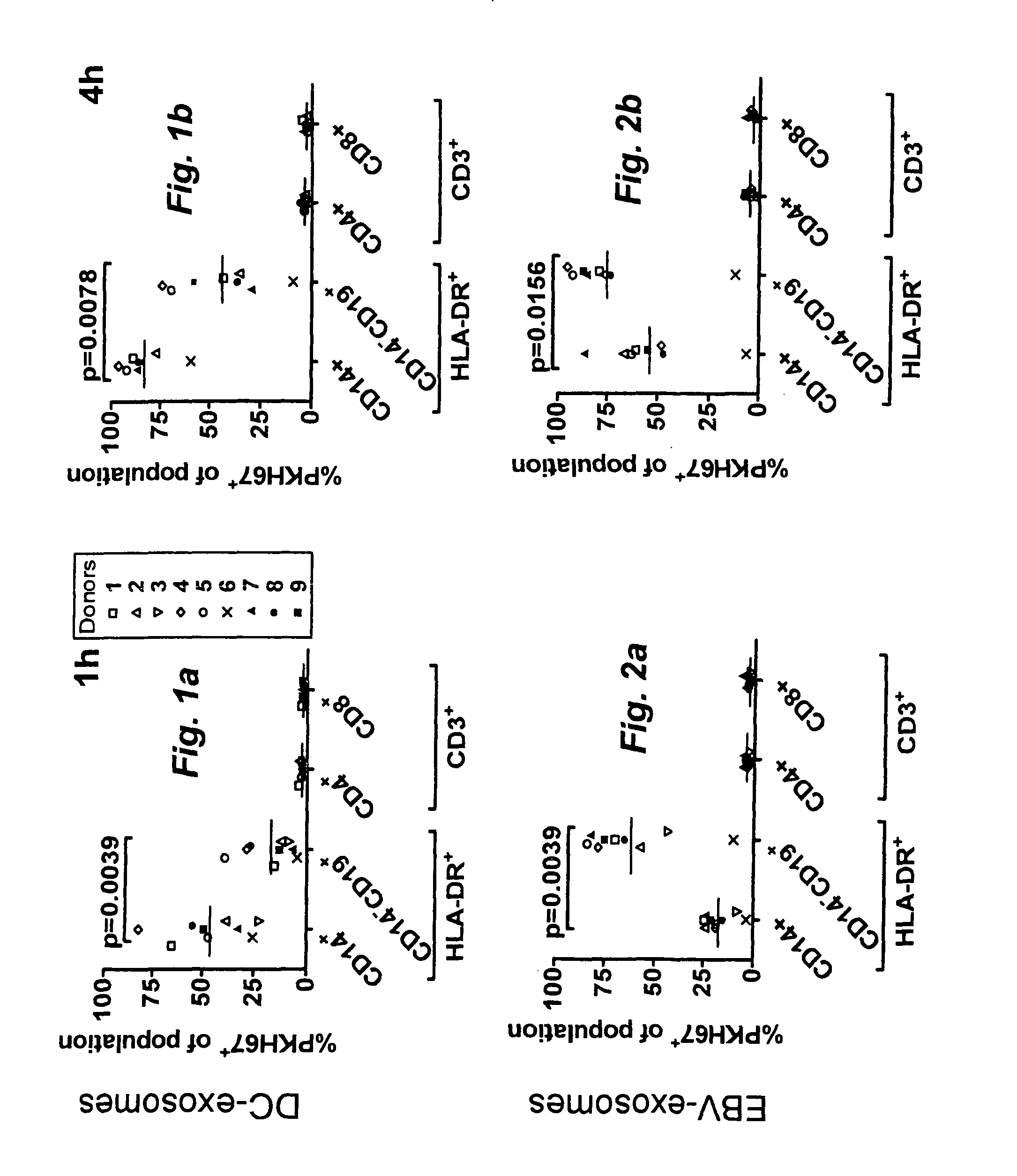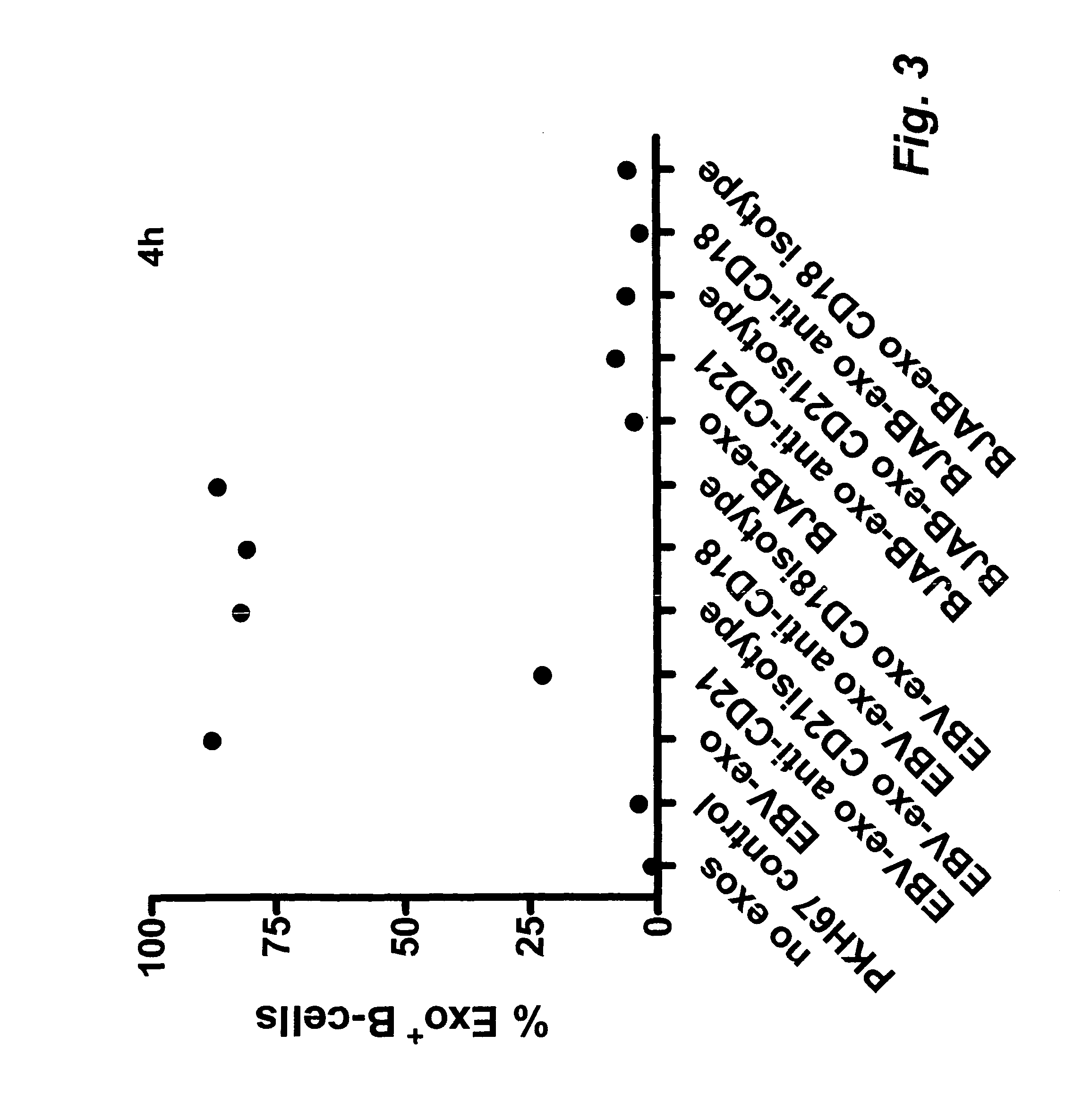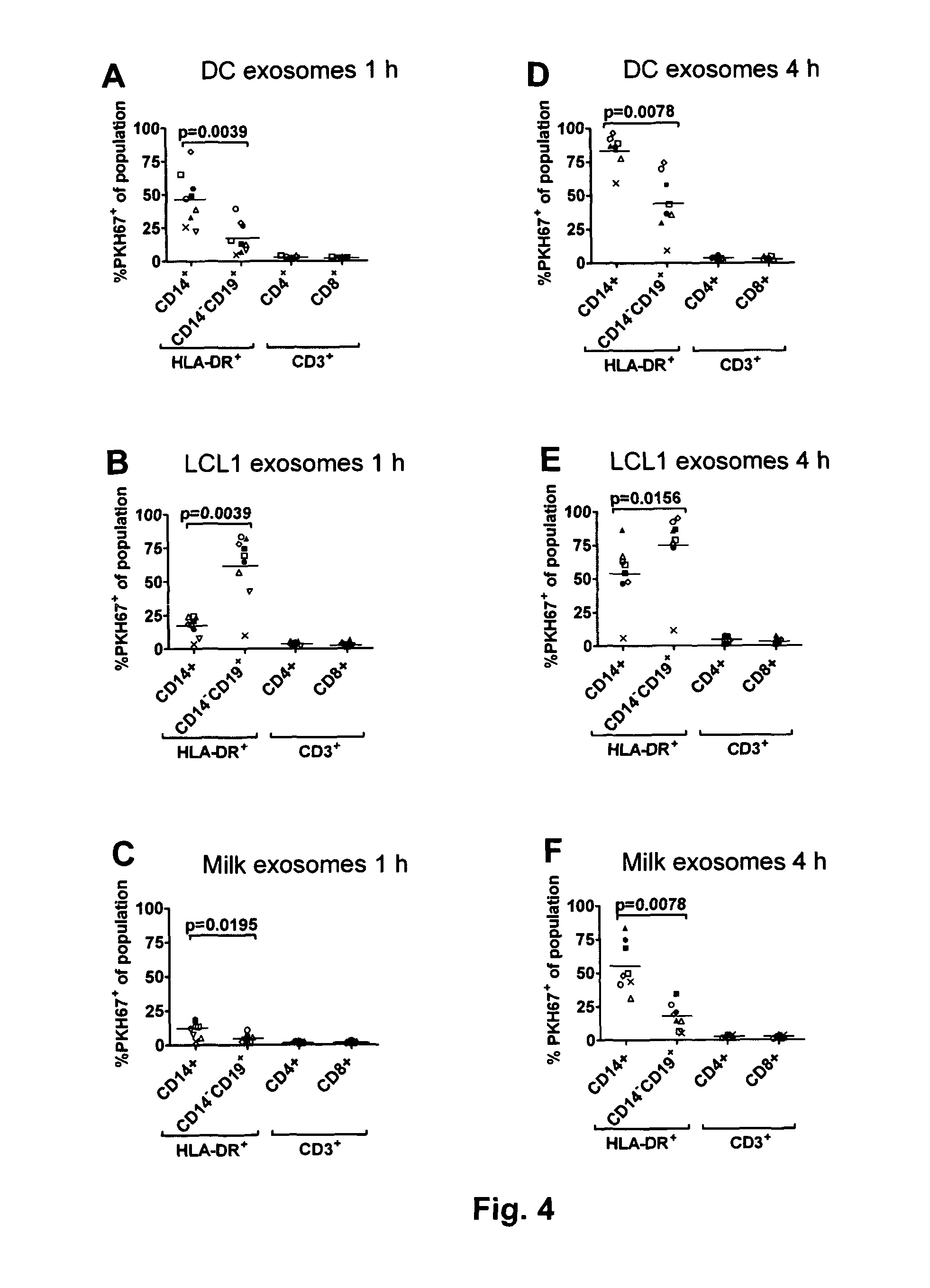[0039]The methods according to the invention enable a higher yield of exosomes which in turns allows for an
effective treatment. The high yield is especially observed in EBV-transformed B-cells. The supernatant of the
cell cultures may be harvested e.g. every two days, such as e.g. every 3rd day, such as e.g. 4th day, such as e.g. 5th day such as e.g. every 6th day, such as e.g. every 7th day and may be harvested during any of the said intervals during a period of at least e.g. 1 month, such as e.g. at least 2 months, such as e.g. at least 3 months, such as e.g. at least 4 months, such as e.g. at least 5 months, such as e.g. at least 6 months.
[0040]The yield of exosomes using the methods according to the invention may be e.g. at least about 0.2 μg exosomes / 1 million EBTB cells, such as e.g. at least about 0.3 μg exosomes / 1 million EBTB cells, such as e.g. at least about 0.4 μg exosomes / 1 million EBTB cells, such as e.g. at least about 0.5 μg exosomes / 1 million EBTB cells, such as e.g. at least about 0.6 μg exosomes / 1 million EBTB cells, such as e.g. at least about 0.7 μg exosomes / 1 million EBTB cells, such as e.g. at least about 0.8 μg exosomes / 1 million EBTB cells, such as e.g. at least about 0.9 μg exosomes / 1 million EBTB cells, such as e.g. at least about 1.0 μg exosomes / 1 million EBTB cells, such as e.g. at least about 1.5 μg exosomes / 1 million EBTB cells, such as e.g. at least about 2.0 μg exosomes / 1 million EBTB cells, such as e.g. at least about 2.5 μg exosomes / 1 million EBTB cells, such as at least e.g. about 3.0 μg exosomes / 1 million EBTB cells, such as e.g. at least about 5.0 μg exosomes / 1 million EBTB cells or such as e.g. at least about 10.0 μg exosomes / 1 million EBTB cells during a period of about e.g. 48 hours of culture of EBTB cells. The inventors of present invention have found that by EBV transformation of B-cells a higher yield of exosomes is observed, which usually is in the range of 0.1 μg exosomes / 1
million cells when e.g. dendritic cells are used and cultured during the same period of time.
[0063]The methods according to the invention enable a higher yield of exosomes which in turns allows for an
effective treatment. The high yield is especially observed in EBV-transformed B-cells. The supernatant of the
cell cultures may be harvested e.g. every two days, such as e.g. every 3rd day, such as e.g. 4th day, such as e.g. 5th day such as e.g. every 6th day, such as e.g. every 7th day and may be harvested during any of the said intervals during a period of at least e.g. 1 month, such as e.g. at least 2 months, such as e.g. at least 3 months, such as e.g. at least 4 months, such as e.g. at least 5 months, such as e.g. at least 6 months.
[0064]The yield of exosomes using the methods according to the invention may be e.g. at least about 0.2 μg exosomes / 1 million EBTB cells, such as e.g. at least about 0.3 μg exosomes / 1 million EBTB cells, such as e.g. at least about 0.4 μg exosomes / 1 million EBTB cells, such as e.g. at least about 0.5 μg exosomes / 1 million EBTB cells, such as e.g. at least about 0.6 μg exosomes / 1 million EBTB cells, such as e.g. at least about 0.7 μg exosomes / 1 million EBTB cells, such as e.g. at least about 0.8 μg exosomes / 1 million EBTB cells, such as e.g. at least about 0.9 μg exosomes / 1 million EBTB cells, such as e.g. at least about 1.0 μg exosomes / 1 million EBTB cells, such as e.g. at least about 1.5 μg exosomes / 1 million EBTB cells, such as e.g. at least about 2.0 μg exosomes / 1 million EBTB cells, such as e.g. at least about 2.5 μg exosomes / 1 million EBTB cells, such as at least e.g. about 3.0 μg exosomes / 1 million EBTB cells, such as e.g. at least about 5.0 μg exosomes / 1 million EBTB cells or such as e.g. at least about 10.0 μg exosomes / 1 million EBTB cells during a period of about e.g. 48 hours of culture of EBTB cells. The inventors of present invention have found that by EBV transformation of B-cells a higher yield of exosomes is observed, which usually is in the range of 0.1 μg exosomes / 1
million cells when e.g. dendritic cells are used and cultured during the same period of time.
[0094]The present invention is based on the insight that exosomes (EBTB exosomes) released by Epstein-
Barr virus-Transformed B cells (EBTB cells) target native B cells via CD21. The insight is supported by the finding that the interaction between EBTB cell exosomes and native B cells is efficiently blocked by anti-CD21, indicating an interaction between CD21 and the EBV
glycoprotein gp350 or other ligands to CD21, e.g. CD 23, C3b, C3d or
interferon-alpha. Other ligands that may be used according to the invention are e.g. BAFF, APRIL, EBV gp350 / 220 (gp350 (470t), CD23, C3b, iC3b, C3d, IFN-alpha. It is envisaged that any ligand or ligands capable of binding to a
B cell receptor can be used according to the invention. The B-cell
receptor may be, but is not limited to CD21 but may also be other receptors on native B-cells such as e.g. CD 19, CD21, CD 20, CD 23, CD79, BAFF-R, TACI, BCMA, IFN-R. Consequently, present invention can be seen as providing a ligand to the exterior of the exosomes capable of binding to a native B-cell and subsequent transfer of the one or more antigens incorporated into the
exosome. This unexpected and surprising finding thus provides a more efficient transfer of the one or more antigens and thereby a more efficient and specific immune response. Importantly, as the exosomes target B-cells and not T-cells a stronger T-
cell response results than would be the case by
direct stimulation of T-cells.
[0095]According to the present invention EBTB exosomes can be engineered in the laboratory to redirect their functional effects, such as by EBV transformation of B cells. The specific targeting of engineered EBTB exosomes towards native B cells potentiates their therapeutic usefulness. Furthermore, EBV transformation of B cells gives an unlimited source of exosomes.
 Login to View More
Login to View More 


